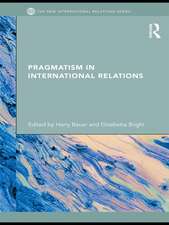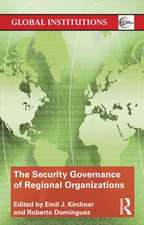Who Will Fight the Next War?: The Changing Face of the American Military
Autor Martin Binkinen Limba Engleză Paperback – iul 1993
The Persian Gulf conflict was the first major combat test for U.S. military forces since the nation ended conscription two decades ago. As hundreds of thousands of American troops were dispatched to the Middle East, the nation realized, seemingly for the first time, that the composition of its armed forces was far removed from any that the nation had previously sent to war.
The deployment of unprecedented proportions of minorities and women and the prominent role of reserves and national guard troops aroused considerable interest, widespread debate, and some worry. The prospect that African Americans could bear a disproportionate share of military casualties generated a socially diverse debate that threatened to reopen old racial scars; the reality that American women were exposed to perils from which, by long and deep tradition, they had previously been shielded inspired calls for them to be admitted to combat specialties; and controversy surrounding the readiness of the Army's combat reserves led to an internecine struggle over the future shape of the U.S. Army.
In this book, Martin Binkin addresses each of these issues in order to provide a better understanding of the composition of America's fighting forces, to prompt an assessment of attitudes toward who should fight in future wars, and to delineate the choices for influencing the social distribution of peril. Binkin argues that the time for public involvement is now, while the memories of the Persian Gulf conflict are still reasonably fresh and while a fundamental rethinking of the post-cold war military is under way.
The deployment of unprecedented proportions of minorities and women and the prominent role of reserves and national guard troops aroused considerable interest, widespread debate, and some worry. The prospect that African Americans could bear a disproportionate share of military casualties generated a socially diverse debate that threatened to reopen old racial scars; the reality that American women were exposed to perils from which, by long and deep tradition, they had previously been shielded inspired calls for them to be admitted to combat specialties; and controversy surrounding the readiness of the Army's combat reserves led to an internecine struggle over the future shape of the U.S. Army.
In this book, Martin Binkin addresses each of these issues in order to provide a better understanding of the composition of America's fighting forces, to prompt an assessment of attitudes toward who should fight in future wars, and to delineate the choices for influencing the social distribution of peril. Binkin argues that the time for public involvement is now, while the memories of the Persian Gulf conflict are still reasonably fresh and while a fundamental rethinking of the post-cold war military is under way.
Preț: 180.87 lei
Nou
Puncte Express: 271
Preț estimativ în valută:
34.61€ • 36.06$ • 28.66£
34.61€ • 36.06$ • 28.66£
Carte tipărită la comandă
Livrare economică 03-17 aprilie
Preluare comenzi: 021 569.72.76
Specificații
ISBN-13: 9780815709558
ISBN-10: 0815709552
Pagini: 192
Dimensiuni: 152 x 229 x 14 mm
Greutate: 0.26 kg
Ediția:New.
Editura: Brookings Institution Press
Colecția Brookings Institution Press
ISBN-10: 0815709552
Pagini: 192
Dimensiuni: 152 x 229 x 14 mm
Greutate: 0.26 kg
Ediția:New.
Editura: Brookings Institution Press
Colecția Brookings Institution Press
Notă biografică
Martin Binkin is a senior fellow in the Brookings Foreign Policy Studies program and the author or coauthor of several books in the Brookings Studies in Defense Policy series.
Descriere
The Persian Gulf conflict was the first major combat test for U.S. military forces since the nation ended conscription two decades ago. As hundreds of thousands of American troops were dispatched to the Middle East, the nation realized, seemingly for the first time, that the composition of its armed forces was far removed from any that the nation had previously sent to war.
The deployment of unprecedented proportions of minorities and women and the prominent role of reserves and national guard troops aroused considerable interest, widespread debate, and some worry. The prospect that African Americans could bear a disproportionate share of military casualties generated a socially diverse debate that threatened to reopen old racial scars; the reality that American women were exposed to perils from which, by long and deep tradition, they had previously been shielded inspired calls for them to be admitted to combat specialties; and controversy surrounding the readiness of the Army's combat reserves led to an internecine struggle over the future shape of the U.S. Army.
In this book, Martin Binkin addresses each of these issues in order to provide a better understanding of the composition of America's fighting forces, to prompt an assessment of attitudes toward who should fight in future wars, and to delineate the choices for influencing the social distribution of peril. Binkin argues that the time for public involvement is now, while the memories of the Persian Gulf conflict are still reasonably fresh and while a fundamental rethinking of the post-cold war military is under way.
The deployment of unprecedented proportions of minorities and women and the prominent role of reserves and national guard troops aroused considerable interest, widespread debate, and some worry. The prospect that African Americans could bear a disproportionate share of military casualties generated a socially diverse debate that threatened to reopen old racial scars; the reality that American women were exposed to perils from which, by long and deep tradition, they had previously been shielded inspired calls for them to be admitted to combat specialties; and controversy surrounding the readiness of the Army's combat reserves led to an internecine struggle over the future shape of the U.S. Army.
In this book, Martin Binkin addresses each of these issues in order to provide a better understanding of the composition of America's fighting forces, to prompt an assessment of attitudes toward who should fight in future wars, and to delineate the choices for influencing the social distribution of peril. Binkin argues that the time for public involvement is now, while the memories of the Persian Gulf conflict are still reasonably fresh and while a fundamental rethinking of the post-cold war military is under way.
















